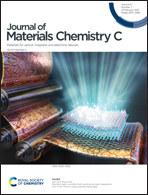Construction of polysiloxane-based fluorescent probe for visualizing pH down-regulation†
Abstract
Changes in the intracellular pH values constitute a significant physiological and pathological process and play vital roles in autophagy, self-repairing, and programmed cell apoptosis. A unique fluorescent probe (PN-1) based on polysiloxanes designed using the intramolecular charge transfer (ICT) mechanism has been developed for the detection of the pH down-regulation process for the first time. PN-1 has been successfully applied to HeLa cells and HepG2 cells for visualizing the pH value changes in a ratiometric manner. The result presented that, in the normal intracellular autophagy process, PN-1 displayed strong blue fluorescence while starvation induced apparent red fluorescence of PN-1. In addition, the inhibitory effect of chloroquine (CQ) to pH value changes during the cell starvation treatment process has been analyzed. The work indicated that a polysiloxane-based fluorescent probe could be applied to detect pH value changes during autophagy, and paved a new avenue for the further design of fluorescent probes for monitoring pH changes.



 Please wait while we load your content...
Please wait while we load your content...